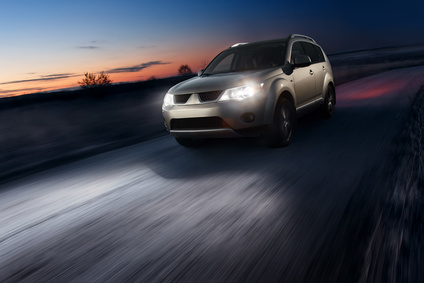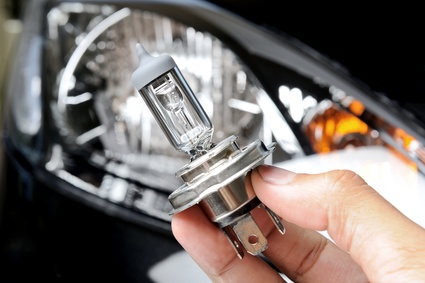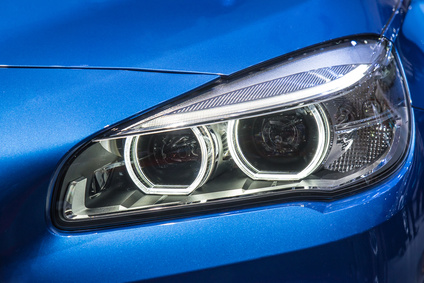With vehicle lighting, the lights on and in a vehicle, above all you need to distinguish between front and rear lights. On the front of the vehicle, two lamps each for high beams, low beams, and parking lights are standard. There are also turn signal lights, also called blinkers. According to the model and age, there may be parking, cornering, and daytime-running lights, as well as auxiliary headlights and fog lamps. For rear lighting there are pairs of tail and brake lights, turn signals, and reflectors. There are also license plate lights, rear fog lamps, and white lights for backing up.
The labeling of motor vehicle lighting is governed by the rules of the Economic Commission for Europe (ECE). Therefore every headlight has a certain certification mark that reflects its purpose. So for example HR stands for a halogen high beam, RL for a daytime-running light, and CR for high and low beam headlights. Also, arrows are imprinted which usually indicate the installation direction and refer to the exterior of the vehicle.
|
At the beginning of automotive history, lanterns were used as illumination, which were later replaced by gas lamps. In 1925 followed the Osram two-filament bulb for combined high and low beams; about 40 years later came the first single-filament halogen lamp. Nowadays xenon and LED lights are being used in more and more cars. On the other hand, laser lights (such as in the BMW i8) are rare. |
 |
Information about the different types of lights:
If manufacturers promise that their incandescent lamps are especially bright and long-lasting, be cautious. The reason: technically that isn't possible. But there are a number of well-balanced products, even if one of the two factors is usually weaker. Many incandescent lamps are advertised as "long life," supposedly lasting a long time. While long-life incandescent lamps often last for several years, particularly bright bulbs usually must be replaced every year. But correctly adjusting the light is just as important as service life and power - it significantly influences the light's effectiveness.
 |
It's a good idea to always change incandescent lamps in pairs, since they often fail one after the other (if they are the same model). Fortunately lawmakers in 2006 introduced a directive whereby the low-beam headlights must be changeable without having to go to a mechanic. For this, after turning off the light and ignition, a locking mechanism is released and the headlight is taken out. Detach the cable, unscrew the lamp and screw in the new one, and put everything back together. Done! Note: when changing the bulb, avoid touching the glass; when it comes into contact with oil or dirt, the bulb can be damaged when it gets hot.
For a long time LED lights were only found as decorations in the interiors ofmodified cars. At the time the technology wasn't yet so developed to the point where LED's were being used in headlights. That changed in 1992, when for the first time a third brake light with an LED was introduced. But it would be 11 more years before the Hella company would introduce the first street-legal full-LED main headlight at the International Motor Show in Frankfurt am Main.
In 2004 LED lights were brought into production as daytime-running lights in the Audi A8 W12. This developed further, with certain car models having full LED lighting. In 2015 the Opel Astra finally came on the market with a full LED Matrix lighting system. This is an electronically controlled LED headlight which makes glare-free high beams possible. The control is done by means of a camera behind the windshield. Even a traffic-circle light has been installed, which uses the navigation system data in premium models.
Despite these innovations, LED lights remain reserved for higher-class vehicles or are available only for an extra charge. This is due to both the high costs of this technology and the output power required. This amounts to around 40 watts with xenon lights, but considerably more with LED lights due to the need for cooling. If this disadvantage is overcome, LED lamps will become much more common in the automotive world.
 |
Xenon lamps can be used in both high and low beam headlights. These are gas-discharge lamps which were introduced by Philips in 1989. Two years later BMW used them for the first time in a standard model, at the time charging an additional fee. Other premium manufacturers followed, installing only one xenon lamp for low and high beams together (the bi-xenon headlight), for example the Mercedes-Benz CL introduced in 1999. Meanwhile, xenon lights are also used in connection with cornering lights.
Xenon lights consist of a quartz glass bulb filled with xenon, metal halides, and often mercury or sodium. In addition, there are two tungsten electrodes with an electrical arc. Compared to halogen lamps, xenon lamps produce their full light power considerably faster (within 15 seconds). A further advantage: xenon lights last four times longer.
The high-voltage pulse (25,000 volts) generated by an electronic ballast leads to the formation of a spark. The ionisation of the gas then produces a current flow between the tungsten electrodes. Through the quickly increasing temperature inside the glass bulb, the metal halides vaporize, producing the typical bluish-colored light of xenon lamps. Even if the light appears cooler, it's brighter than that of conventional incandescent lamps for vehicle lighting.
There are xenon lamps in categories D1, D1S, D1R, D2S, D2R, D3S, D3R, D4S, D4R and D-H4R, in which the letter D stands for the word "discharge". DxS lamps are for headlights with projection systems, DxR lamps for reflector headlights. Lamps in categories D3 and D4 contain no mercury, in contrast with D1 and D2, but cannot be used in their place. Therefore, for safety reasons they have a different fitting configuration.